Homogeneity Detection and Adjustment of Sea Surface Salinity along the Coast of the Northern South China Sea
Abstract
:1. Introduction
2. Data and Methods
2.1. Data and Metadata
2.2. Data Processing and Analysis Method
2.2.1. Data Preprocessing
- The format of data files should meet the requirements of standard formats;
- The observed values of the elements should meet their physical characteristics and measurement accuracy requirements.
2.2.2. Penalized Maximum F Test (PMF) Principle
2.2.3. Statistical Analysis Method
3. Results
3.1. Breakpoint Detection and Main Reasons for Inhomogeneity of the SSS Series
3.2. Analysis of Linear Trend Estimation of SSS Series before and after Homogenization Adjustment
3.3. Individual Case Analysis
3.3.1. Detection and Adjustment of Monthly Mean SSS Series of NZU Station
3.3.2. Detection and Adjustment of Monthly Mean SSS Series at the HKO Station
4. Discussion
5. Conclusions
- All six SSS series were affected by non-climate factors. The main reason for the detected inconsistencies is the changes in instruments, particularly with the transition of the station system. Of the stations, BHI and WZU were the most affected by non-climate factors, with five breakpoints, while ZPO was the least with two breakpoints.
- The long-term fluctuations in homogenized SSS in the northern SCS showed notable regional variations. The coastal SSS measurements obtained from the BHI, HKO and QLN stations in Guangxi and Hainan Provinces exhibited a significant increase in salinity levels from 1960 to 2018. Nevertheless, the measurements obtained from the WZU, ZPO and NZH stations exhibited a distinct trend of desalination.
Author Contributions
Funding
Data Availability Statement
Acknowledgments
Conflicts of Interest
References
- Cai, R.; Liu, K.; Tan, H. Impacts and risks of climate change on China’s coastal zones and seas and related adaptation. Chin. J. Popul. 2020, 30, 1–8. [Google Scholar]
- Wang, F.; Li, X.; Tang, X.; Sun, X.; Zhang, J.; Yang, D.; Xu, L.; Zhang, H.; Yuan, H.; Wang, Y.; et al. The seas around China in a warming climate. Nat. Rev. Earth Environ. 2023, 4, 535–551. [Google Scholar] [CrossRef]
- Röthig, T.; TrevathanTackett, S.M.; Voolstra, C.R.; Ross, C.; Chaffron, S.; Durack, P.J.; Warmuth, L.M.; Sweet, M. Human-induced salinity changes impact marine organisms and ecosystems. Glob. Chang. Biol. 2023, 29, 4731–4749. [Google Scholar] [CrossRef] [PubMed]
- Vasiliev, I.; Karakitsios, V.; Bouloubassi, I.; Agiadi, K.; Kontakiotis, G.; Antonarakou, A.; Triantaphyllou, M.; Gogou, A.; Kafousia, N.; Rafélis, M.; et al. Large Sea Surface Temperature, Salinity, and Productivity-Preservation Changes Preceding the Onset of the Messinian Salinity Crisis in the Eastern Mediterranean Sea. Paleoceanogr. Paleoclimatol. 2019, 34, 182–202. [Google Scholar] [CrossRef]
- Liu, F.; Zhang, H.; Ming, J.; Zheng, J.; Tian, D.; Chen, D. Importance of Precipitation on the Upper Ocean Salinity Response to Typhoon Kalmaegi (2014). Water 2020, 12, 614. [Google Scholar] [CrossRef]
- Yang, Y.; Guo, Y.; Zeng, L.; Wang, Q. Eddy-induced sea surface salinity changes in the South China Sea. Front. Mar. Sci. 2023, 10, 1113752. [Google Scholar]
- Ge, K.; Li, Y.; Lyu, Y.; Lin, P.; Cheng, L.; Wang, F. Surface Salinity Changes of the Tropical and Subtropical Oceans Since 1970 and Their Relationship With Surface Freshwater Fluxes. J. Geophys. Res. Ocean. 2023, 128, e2023JC020207. [Google Scholar] [CrossRef]
- Ankrah, J.; Monteiro, A.; Madureira, H. Climate Variability, Coastal Livelihoods, and the Influence of Ocean Change on Fish Catch in the Coastal Savannah Zone of Ghana. Water 2024, 16, 1201. [Google Scholar] [CrossRef]
- Wang, G.; Li, Y.; Hou, M.; Fan, W.; Liu, K.; Wang, H.; Gao, J.; Li, C. Homogeneity study of the sea surface temperature data over the South China Seas using PMT method. J. Trop. Meteorol. 2017, 33, 637–643, (In Chinese with English Abstract). [Google Scholar]
- Li, Q.; Li, W. Construction of the gridded historic temperature dataset over China during the recent half century. Acta Meteorol. Sin. 2007, 02, 293–300, (In Chinese with English Abstract). [Google Scholar] [CrossRef]
- Li, Q.; Liu, X.; Zhang, H.; Peterson, T.C.; Easterling, D.R. Detecting and adjusting temporal inhomogeneity in Chinese mean surface air temperature data. Adv. Atmos. Sci. 2004, 21, 260–268. [Google Scholar] [CrossRef]
- Si, P.; Hao, L.; Luo, C.; Cao, X.; Liang, D. The Interpolation and Homogenization of Long-Term Temperature Time Series at Baoding Observation Station in Hebei Province. Adv. Clim. Chang. Res. 2017, 13, 41–51, (In Chinese with English Abstract). [Google Scholar]
- Zhu, Y.; Cao, L.; Tang, G.; Zhou, Z. Homogenization of Surface Relative Humidity over China. Adv. Clim. Chang. Res. 2015, 11, 379–386, (In Chinese with English Abstract). [Google Scholar]
- Li, Y.; Mu, L.; Wang, Q.; Ren, G.; You, Q. High-quality sea surface temperature measurements along coast of the Bohai and Yellow Seas in China and their long-term trends during 1960–2012. Int. J. Climatol. 2020, 40, 63–76. [Google Scholar] [CrossRef]
- GB/T 14914-94; 1st ed. The Specification for Offshore Observation. China Standards Press: Beijing, China, 1994; pp. 1–100. (In Chinese)
- GB/T 14914-2006; 1st ed. The Specification for Offshore Observation. China Standards Press: Beijing, China, 2006; pp. 1–83. (In Chinese)
- Lü, H.; Xie, J.; Xu, J.; Chen, Z.; Liu, T.; Cai, X. Force and torque exerted by internal solitary waves in background parabolic current on cylindrical tendon leg by numerical simulation. Ocean Eng. 2016, 114, 250–258. [Google Scholar] [CrossRef]
- Guan, M.; Cheng, Y.; Li, Q.; Wang, C.; Fang, X.; Yu, J. An Effective Method for Submarine Buried Pipeline Detection via Multi-Sensor Data Fusion. IEEE Access 2019, 7, 125300–125309. [Google Scholar] [CrossRef]
- Guan, M.; Li, Q.; Zhu, J.; Wang, C.; Zhou, L.; Huang, C.; Ding, K. A method of establishing an instantaneous water level model for tide correction. Ocean Eng. 2019, 171, 324–331. [Google Scholar] [CrossRef]
- Reeves, J.; Chen, J.; Wang, X.L.; Lund, R.; Lu, Q. A Review and Comparison of Changepoint Detection Techniques for Climate Data. J. Appl. Meteorol. Clim. 2007, 46, 900–915. [Google Scholar] [CrossRef]
- Wang, X.L. Accounting for Autocorrelation in Detecting Mean Shifts in Climate Data Series Using the Penalized Maximal t or F Test. J. Appl. Meteorol. Climatol. 2008, 47, 2423–2444. [Google Scholar] [CrossRef]
- Wang, X.L. Penalized Maximal F Test for Detecting Undocumented Mean Shift without Trend Change. J. Atmos. Ocean. Technol. 2008, 25, 368–384. [Google Scholar] [CrossRef]
- ETCCDI Climate Change Indices. Available online: https://etccdi.pacificclimate.org/software.shtml (accessed on 1 September 2021).
- Wang, X.L.; Chen, H.; Wu, Y.; Feng, Y.; Pu, Q. New Techniques for the Detection and Adjustment of Shifts in Daily Precipitation Data Series. J. Appl. Meteorol. Climatol. 2011, 49, 2416–2436. [Google Scholar] [CrossRef]
- Sen, P. Estimated of the regression coefficient based on Kendall’s Tau. J. Am. Stat. Assoc. 1968, 39, 1379–1389. [Google Scholar] [CrossRef]
- Wu, H.; Hu, D.; Xing, C.; Zhu, J. Characteristics of different types of precipitation and their influences on drought and flood over Hainan Island in summer. Torrential Rain Disasters 2021, 40, 558–563, (In Chinese with English Abstract). [Google Scholar]
- Luo, J.; Wang, H.; Wang, A.; Fan, W.; Quan, M.; Zhang, J.; Wang, D. The precipitation changes in the coastal areas of China under the background of global climate warming. Mar. Sci. Bull. (Chin. Ed.) 2023, 42, 151–158, (In Chinese with English Abstract). [Google Scholar]
- Guo, Z. Anomalies of sea surface temperature and salinity in Beibu Gulf during El Niño events. Trop. Oceanol. 1989, 8, 52–57, (In Chinese with English Abstract). [Google Scholar]
- He, G.; Lu, W.; Liu, Y. An analysis on the periodicity of seawater salinity along the coast of Guangdong and Guangxi. Trop. Oceanol. 1993, 12, 25–30, (In Chinese with English Abstract). [Google Scholar]
- Wang, L.; Li, Q.; Mao, X.; Bi, H.; Peng, Y. Interannual sea level variability in the Pearl River Estuary and its response to El Niño–Southern Oscillation. Glob. Planet. Chang. 2018, 162, 163–174. [Google Scholar] [CrossRef]
- China Meteorological Administration. Blue Book on Climate Change of China 2019, 1st ed.; China Meteorological Administration: Beijing, China, 2019; pp. 1–80.
- Pang, S.; Wang, X.; Liu, H.; Zhou, G.; Fan, K. Decadal Variability of the Barrier Layer and Forcing Mechanism in the Bay of Bengal. J. Geophys. Res. Ocean. 2019, 124, 5289–5307. [Google Scholar] [CrossRef]
- Climate Change 2021: Summary for Policymakers. Available online: https://www.ipcc.ch/report/ar6/wg1/downloads/report/IPCC_AR6_WGI_SPM.pdf (accessed on 9 August 2021).
- Liao, Q.; You, M.; Liu, X. Analysis of Climate Change Characteristics in the Near Sea of Weizhou Island over the Past 30 Years. J. Meteor. Res. Appl. 2012, 33, 140–141, (In Chinese with English Abstract). [Google Scholar]
- Li, J.; Bai, A.; Cai, Q. Climate Change Characteristics of the Xisha Islands and Weizhou Island in China and the Comparison with the Coastal Land. Trop. Geo. 2018, 38, 72–81, (In Chinese with English Abstract). [Google Scholar]
- Du, Y.; Zhang, Y.; Feng, M.; Wang, T.; Zhang, N.; Wijffels, S. Decadal trends of the upper ocean salinity in the tropical Indo-Pacific since mid-1990s. Sci. Rep. 2015, 5, 16050. [Google Scholar] [CrossRef] [PubMed]
- Ramos, R.D.; Goodkin, N.F.; Siringan, F.P.; Hughen, K.A. Coral records of temperature and salinity in the tropical western Pacific reveal influence of the Pacific decadal oscillation since the late nineteenth century. Paleoceanogr. Paleocl. 2019, 34, 1344–1358. [Google Scholar] [CrossRef]
- Hu, S.; Sprintall, J.; Guan, C.; Hu, D.; Wang, F.; Lu, X.; Li, S. Observed triple mode of salinity variability in the thermocline of tropical Pacific Ocean. J. Geophys. Res. Ocean. 2020, 125, e2020JC016210. [Google Scholar] [CrossRef]
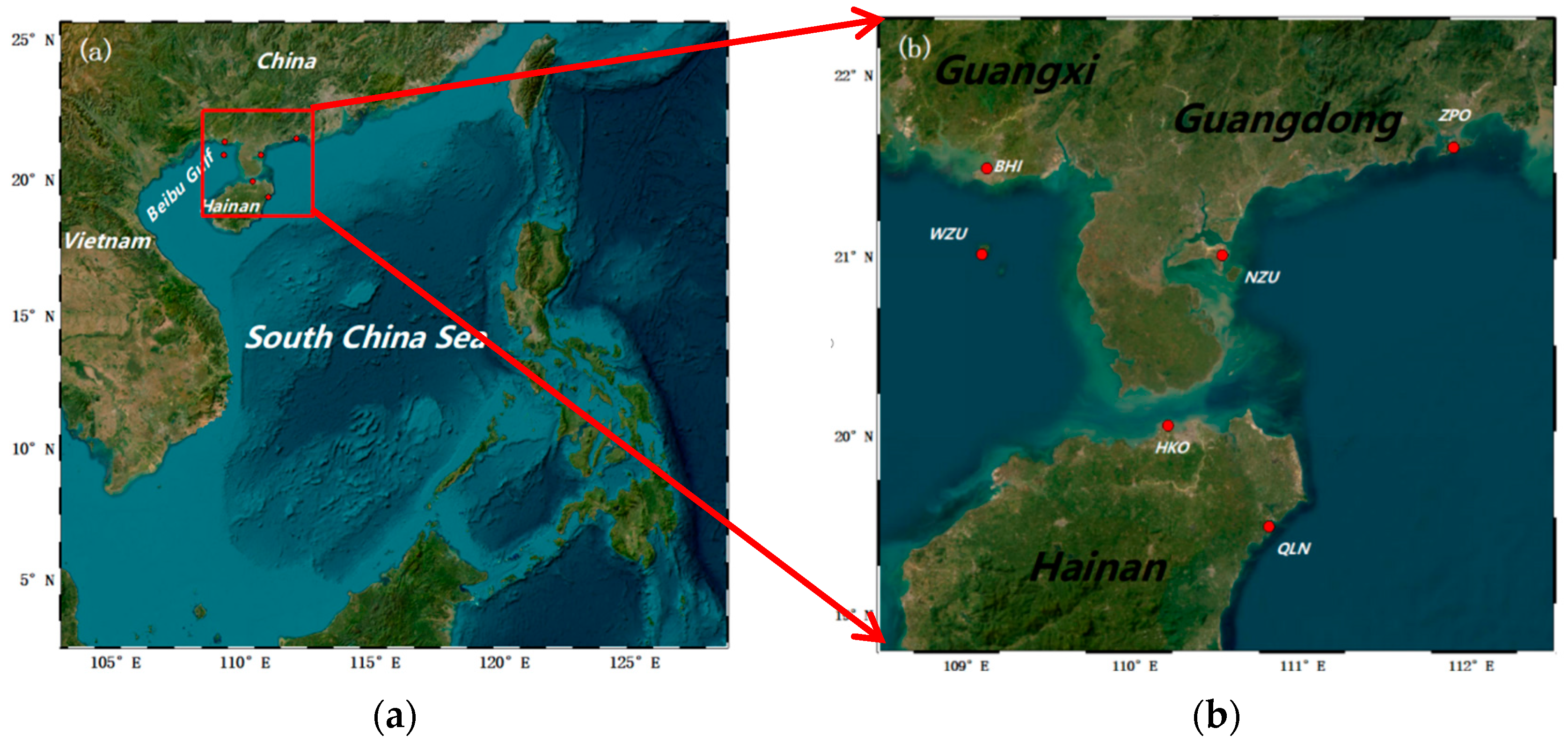

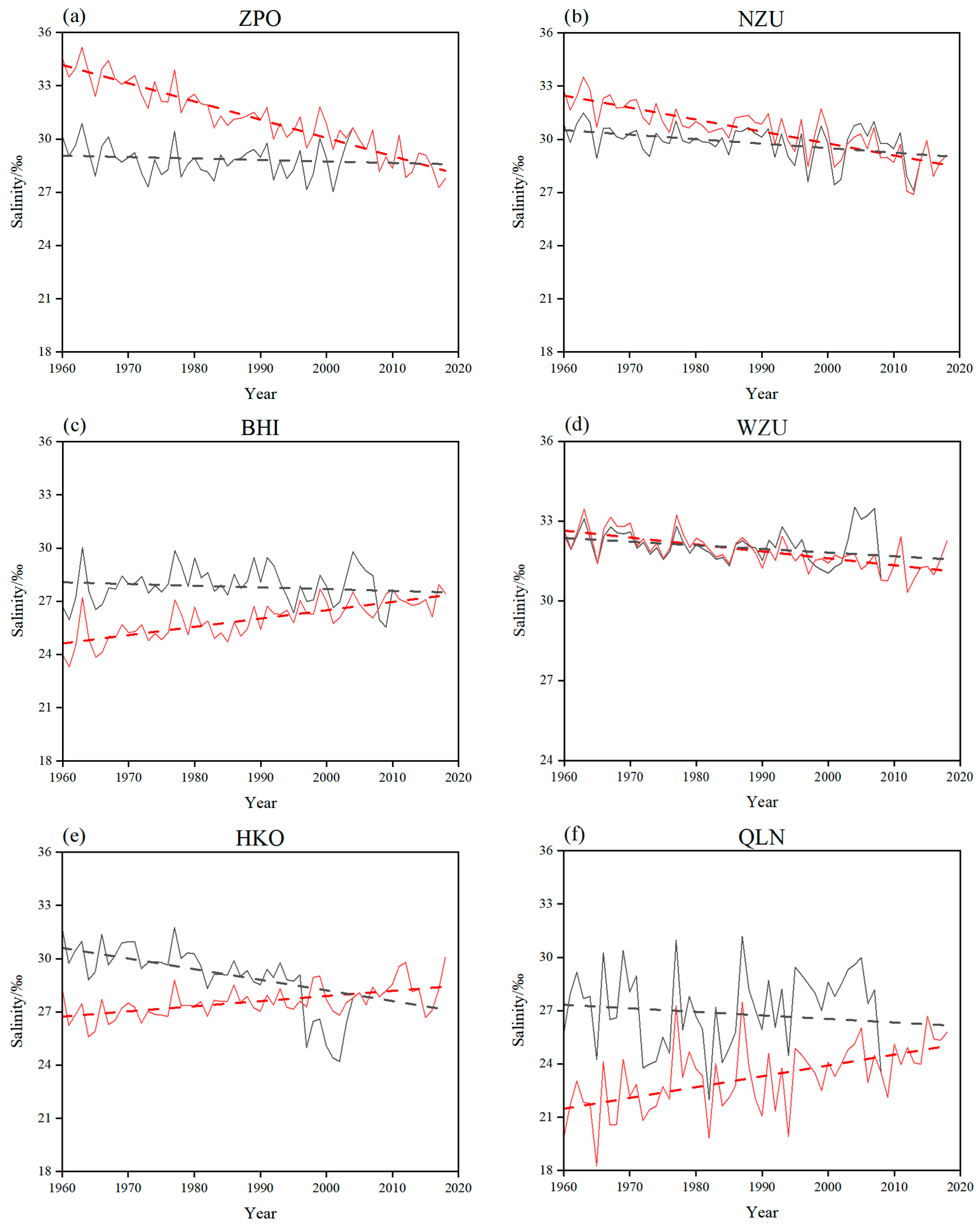
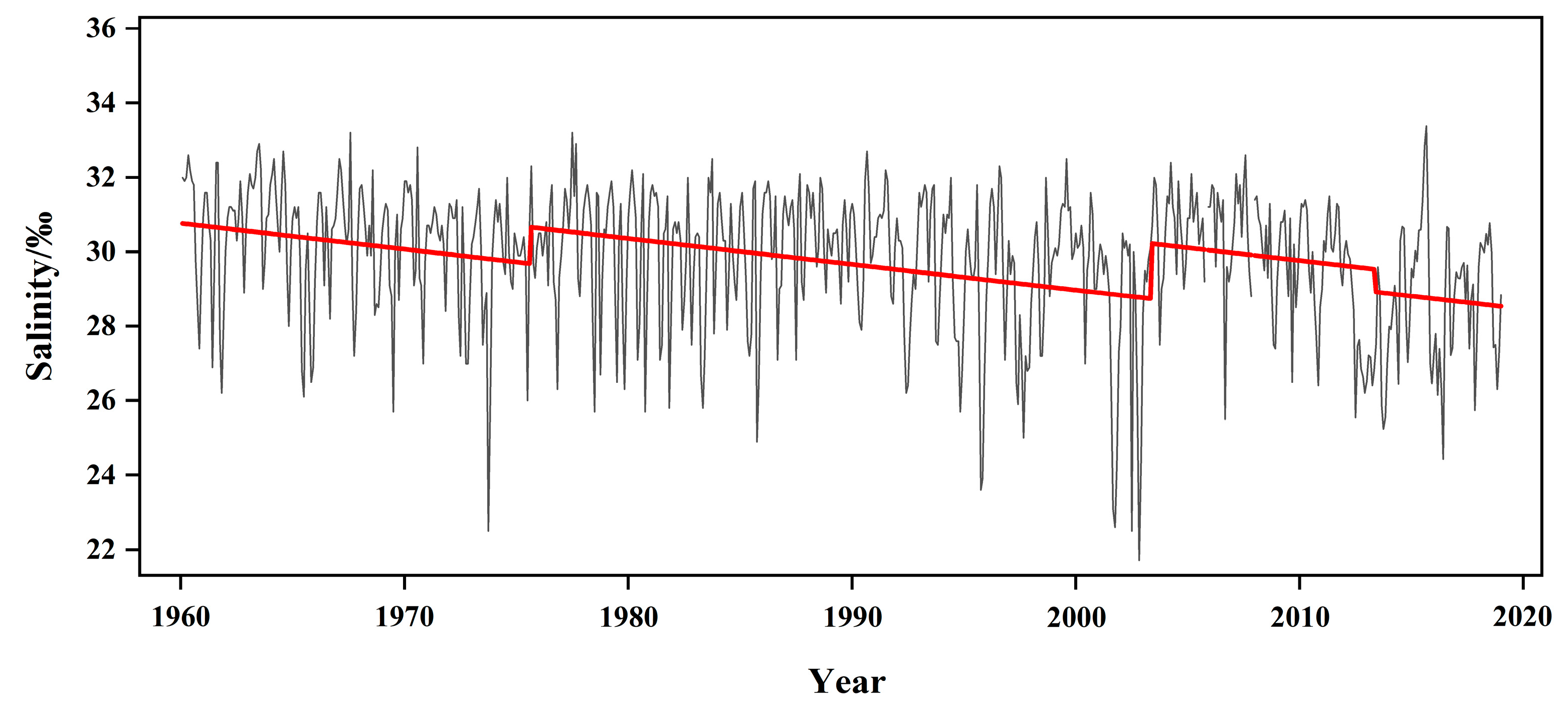
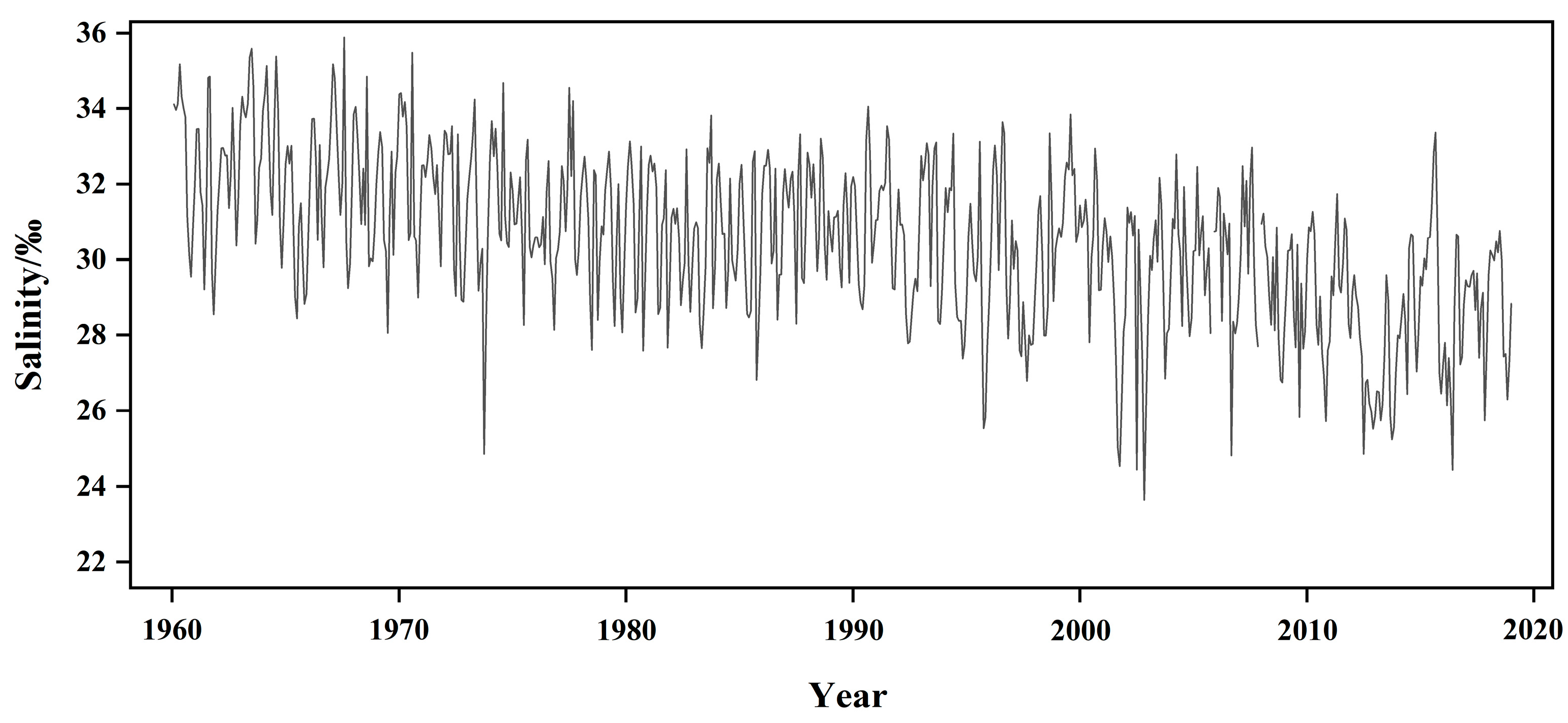
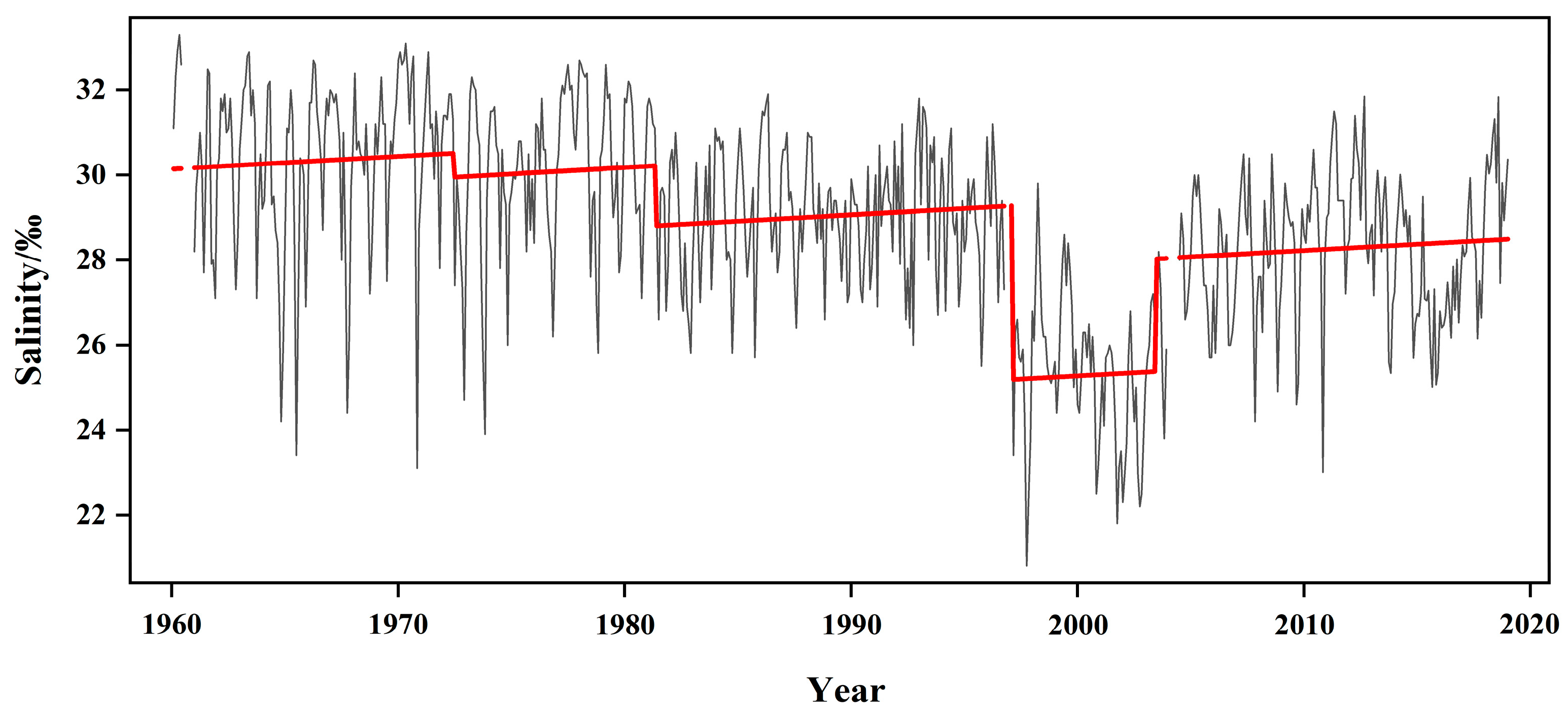

| Station Name | Abbr. | Annual Mean | Maximum SSS | Minimum SSS | Annual Range | Standard Deviation |
|---|---|---|---|---|---|---|
| Zhapo | ZPO | 28.83 | 31.60 | 24.05 | 7.55 | 2.60 |
| Naozhou | NZU | 29.78 | 31.78 | 26.79 | 4.98 | 1.85 |
| Beihai | BHI | 27.27 | 30.32 | 23.93 | 6.39 | 2.21 |
| Weizhou | WZU | 31.63 | 33.06 | 30.51 | 2.55 | 1.06 |
| Haikou | HKO | 28.16 | 30.90 | 25.88 | 5.02 | 2.27 |
| Qinglan | QLN | 25.64 | 32.20 | 15.64 | 16.55 | 5.90 |
| No. | Observation Time | Observation Instrument | Implementation of the Seaside Observation Specifications |
|---|---|---|---|
| 1 | June 2002~July 2003 | YZY 4-1 temperature and salt sensor | GB14914-94 [15] The specification for offshore observation |
| 2 | August 2003~present | SYC2-2 electrode type salinometer | GB14914-94 The specification for offshore observation GB14914-2006 [16] The specification for offshore observation |
| No. | Observation Time | Observation Instrument | Implementation of the Seaside Observation Specifications |
|---|---|---|---|
| 1 | April 1982~September 1989 | WUS-type induction salinometer | Code for Waterfront Observation State Oceanic Administration |
| 2 | January 1997~September 2002 | SYA 2-2 laboratory salinometer | GB/T 14914-94 The specification for offshore observation |
| 3 | October 2002~present | SYA 2-1 laboratory salinometer | GB/T 14914-94 The specification for offshore observation |
| Station Name | Linear Trend Rate Comparison/‰ | ||||
|---|---|---|---|---|---|
| Rate before Adjustment | p | Rate after Adjustment | p | Deviation | |
| ZPO | −0.008 | 0.24 | −0.103 | 5.08 × 10–26 | −0.094 |
| NZU | −0.025 | 4.35 × 10–4 | −0.068 | 2.01 × 10–15 | −0.042 |
| BHI | −0.010 | 0.22 | 0.047 | 4.45 × 10–12 | 0.056 |
| WZU | −0.014 | 7.88 × 10–3 | −0.026 | 1.76 × 10–9 | −0.012 |
| HKO | −0.060 | 2.86 × 10–7 | 0.029 | 3.98 × 10–6 | 0.089 |
| QLN | −0.031 | 0.08 | 0.061 | 3.41 × 10–5 | 0.092 |
| Station Name | Total Number of Breakpoints |
|---|---|
| ZPO | 2 |
| NZU | 3 |
| BHI | 5 |
| WZU | 5 |
| HKO | 4 |
| QLN | 3 |
| Breakpoint Time | Detection Statistic | 95% Confidence Interval | Adjusted Value (Unit: ‰) |
|---|---|---|---|
| July 1975 | 10.8321 | 31.5437~41.9330 | 1.77 |
| April 2003 | 34.5494 | 31.3746~41.6887 | 0.80 |
| April 2013 | 5.0618 | 29.9585~39.7163 | −0.69 |
| Breakpoint Time | Detection Statistic | 95% Confidence Interval | Adjusted Value (Unit: ‰) |
|---|---|---|---|
| May 1972 | 34.2798 | 29.7167~39.5360 | −0.57 |
| April 1981 | 34.5999 | 29.9932~39.9183 | −1.41 |
| January 1997 | 34.3691 | 29.7938~39.6427 | −4.10 |
| May 2003 | 34.3319 | 29.7617~39.5983 | 2.65 |
Disclaimer/Publisher’s Note: The statements, opinions and data contained in all publications are solely those of the individual author(s) and contributor(s) and not of MDPI and/or the editor(s). MDPI and/or the editor(s) disclaim responsibility for any injury to people or property resulting from any ideas, methods, instructions or products referred to in the content. |
© 2024 by the authors. Licensee MDPI, Basel, Switzerland. This article is an open access article distributed under the terms and conditions of the Creative Commons Attribution (CC BY) license (https://creativecommons.org/licenses/by/4.0/).
Share and Cite
Huang, J.; You, D.; Li, Y. Homogeneity Detection and Adjustment of Sea Surface Salinity along the Coast of the Northern South China Sea. Water 2024, 16, 1895. https://doi.org/10.3390/w16131895
Huang J, You D, Li Y. Homogeneity Detection and Adjustment of Sea Surface Salinity along the Coast of the Northern South China Sea. Water. 2024; 16(13):1895. https://doi.org/10.3390/w16131895
Chicago/Turabian StyleHuang, Jingyi, Dawei You, and Yan Li. 2024. "Homogeneity Detection and Adjustment of Sea Surface Salinity along the Coast of the Northern South China Sea" Water 16, no. 13: 1895. https://doi.org/10.3390/w16131895






